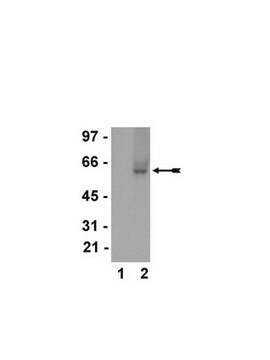07-482
Anti-Calmodulin Binding Protein Epitope Tag Antibody
Upstate®, from rabbit
Zaloguj sięWyświetlanie cen organizacyjnych i kontraktowych
About This Item
Kod UNSPSC:
12352203
eCl@ss:
32160702
NACRES:
NA.41
Polecane produkty
pochodzenie biologiczne
rabbit
Poziom jakości
forma przeciwciała
purified antibody
rodzaj przeciwciała
primary antibodies
klon
polyclonal
oczyszczone przez
affinity chromatography
reaktywność gatunkowa
E. coli
producent / nazwa handlowa
Upstate®
metody
western blot: suitable
izotyp
IgG
Warunki transportu
wet ice
docelowa modyfikacja potranslacyjna
unmodified
Opis ogólny
Calmodulin (CaM), a small 17 kDa ubiquitous Ca2+-binding protein acts as an intracellular Ca2+ receptor and transduces Ca2+ transients, usually in response to growth factors. It mediates the activity of a number of Ca2+ regulating enzymes, including protein kinases, phosphatases, nitric oxide synthases, and phosphodiesterase.
Specyficzność
Recognizes recombinant proteins containing the calmodulin binding protein epitope tag.
Immunogen
KLH-conjugated, synthetic peptide (MKRRWKKNFIAVSAANRFKKISSSGAL) corresponding to the Calmodulin Binding Protein (CBP) epitope tag found in several E. coli expression vectors. The immunizing sequence is identical in rabbit, mouse, and rat.
Zastosowanie
Anti-Calmodulin Binding Protein Epitope Tag Antibody detects level of Calmodulin Binding Protein Epitope Tag & has been published & validated for use in WB.
Jakość
Routinely evaluated by Western Blot in lysates from transformed E. coli.
Western Blot Analysis:
A 1:2000-1:10000 dilution of this lot detected a recombinant protein containing the calmodulin binding protein epitope tag in lysates from transformed E. coli.
Western Blot Analysis:
A 1:2000-1:10000 dilution of this lot detected a recombinant protein containing the calmodulin binding protein epitope tag in lysates from transformed E. coli.
Opis wartości docelowych
The molecular weight is related to the tagged protein.
Postać fizyczna
Purified rabbit IgG in buffer containing 0.1M Tris-Glycine, 0.15M NaCl, 0.05% Sodium Azide, pH7.4.
Komentarz do analizy
Control
Lysates from transformed E. coli.
Lysates from transformed E. coli.
Inne uwagi
Concentration: Please refer to the Certificate of Analysis for the lot-specific concentration.
Informacje prawne
UPSTATE is a registered trademark of Merck KGaA, Darmstadt, Germany
Not finding the right product?
Try our Narzędzie selektora produktów.
Kod klasy składowania
12 - Non Combustible Liquids
Klasa zagrożenia wodnego (WGK)
WGK 1
Temperatura zapłonu (°F)
Not applicable
Temperatura zapłonu (°C)
Not applicable
Certyfikaty analizy (CoA)
Poszukaj Certyfikaty analizy (CoA), wpisując numer partii/serii produktów. Numery serii i partii można znaleźć na etykiecie produktu po słowach „seria” lub „partia”.
Masz już ten produkt?
Dokumenty związane z niedawno zakupionymi produktami zostały zamieszczone w Bibliotece dokumentów.
Weijun Chen et al.
RNA (New York, N.Y.), 20(3), 308-320 (2014-01-21)
Excision of introns from pre-mRNAs is mediated by the spliceosome, a multi-megadalton complex consisting of U1, U2, U4/U6, and U5 snRNPs plus scores of associated proteins. Spliceosome assembly and disassembly are highly dynamic processes involving multiple stable intermediates. In this
Role of km23-1 in RhoA/actin-based cell migration.
Jin, Q; Pulipati, NR; Zhou, W; Staub, CM; Liotta, LA; Mulder, KM
Biochemical and biophysical research communications null
Development of the "Three-step MACS": a novel strategy for isolating rare cell populations in the absence of known cell surface markers from complex animal tissue.
Lee, MY; Lufkin, T
Journal of biomolecular techniques : JBT null
Angelo Pidroni et al.
Frontiers in microbiology, 9, 2212-2212 (2018-10-05)
An outstanding feature of filamentous fungi is their ability to produce a wide variety of small bioactive molecules that contribute to their survival, fitness, and pathogenicity. The vast collection of these so-called secondary metabolites (SMs) includes molecules that play a
Ingo Bauer et al.
mBio, 7(6) (2016-11-03)
Histone deacetylases (HDACs) remove acetyl moieties from lysine residues at histone tails and nuclear regulatory proteins and thus significantly impact chromatin remodeling and transcriptional regulation in eukaryotes. In recent years, HDACs of filamentous fungi were found to be decisive regulators
Nasz zespół naukowców ma doświadczenie we wszystkich obszarach badań, w tym w naukach przyrodniczych, materiałoznawstwie, syntezie chemicznej, chromatografii, analityce i wielu innych dziedzinach.
Skontaktuj się z zespołem ds. pomocy technicznej







